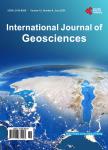Deep-Sea Benthic Foraminiferal Distribution in South West Indian Ocean: Implications to Paleoecology
Deep-Sea Benthic Foraminiferal Distribution in South West Indian Ocean: Implications to Paleoecology作者机构:不详
出 版 物:《International Journal of Geosciences》 (地球科学国际期刊(英文))
年 卷 期:2010年第1卷第2期
页 面:79-86页
学科分类:1002[医学-临床医学] 100214[医学-肿瘤学] 10[医学]
主 题:Paleoecology Benthicforaminifera Holocene Indian Ocean
摘 要:Five grab samples from the southwestern part of the Indian ocean were collected by ORV Sagar Kanya during the third expedition to the southern Indian ocean in June 2009. The sediment samples have been analyzed and recorded 36 benthic foraminiferal species belonging to 21 genera and 3 suborders. All the species were taxonomically identified, SEM photographed and illustrated. Deep sea-benthic foraminiferal species at different locations of South of West India Ocean (3150-4125 m water depth) is examined in terms of number of species (n) and diversity (d). The observed depth ranges of benthic foraminifera have been documented to recognize their bathymetric distribution. The valves of these parameters reached their maximum at 3190 m water depth. Productivity continued in the Indo-Pacific Ocean (the biogenic boom) and the Oxygen minimum zone (OMZ) intensified over large parts of Indian Ocean continually. The diversity values show more abrupt trend as depth increases. Species like Epistominella exigua and Pullenia bulloides occur at both 3150 m & 3465 m depths indicating depth persistence. Further, Oridorsalis umbonatus and Melonis sphaeroides occur at both 3150 m & 3465 m depths. Species like Gyroidina sp an indicate of low oxygen environment and Uvigerina hispida-costata indicative of high organic carbon are found to occur at 3150 m & 3740 m respectively. Factor analysis and Pearson correlation matrix was performed on foraminiferal census data of 10 highest ranked species which are present in at least one sample. 3 factors were obtained accounting for 72.81% of the total variance. Thus the study suggests that fluctuations in species diversity at the locations of the present study were related to changes in productivity during the geological past. Further, the faunal data do indicate the early Holocene Indian Ocean was influenced by increased ventilation perhaps by North Atlantic deep water and or circumpolar deep waters.



